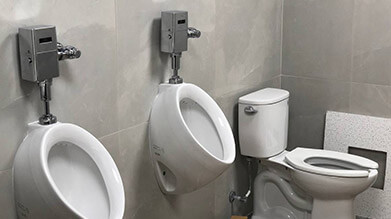
Apparently, your bathroom has a plumbing problem. Something like a leaky faucet, a faulty sink, or a clogged toilet. You’re confident that you don’t need a plumber to fix the problem, and you’re up to the task. We’re not judging, but we can offer a little bit of help. Here are a few tips to do and not to do while trying to fix your faulty sink, shower, tub, or toilet. Stay with us to learn from the best!
• Not turning off the main water line
The first and most important tip you can get from us is to turn off the main water line before you do anything related to your toilet. You can do this using your main line valve whose location may vary depending on where you live and whether you are on a well or city water. If you open your toilet pipes without turning off the current, you’re asking for flooding and an expensive cleanup operation afterward. Even if your sink or toilet has its little shut-off valve, it’s safer to cut off the source. This way, if said fixture mini valve leaks or you suddenly need to repair something else, you’re prepared.
• Using galvanized pipes
There are written codes for different types of pipes and their specific properties. Some of the more helpful ones include International Plumbing Code and Uniform Plumbing Code which you can get by just a little online searching. One of the more important notes you’re guaranteed to find in those is about galvanized pipes: They’ve been implicated in lead poisoning and are prone to rot on the inside. Other than that, you just need to check your wallet to see what you can get for your home.
• The incorrect slope of the shower pan
Typically shower pans have a specific slope to provide optimum drainage. The incorrect slope can be a huge problem because it helps mold growth and is surely unsanitary. You can use the aforementioned codes to find the correct slope, but more experienced plumbers will recommend a quarter of an inch per foot for your shower slope. If you still have problems with this tip, there are pre-pitch standard installation kits at home improvement stores you can use for this.
• Using a faulty toilet flange
Installing a toilet needs you to be careful and pay attention. One of the most important details about it is the flange: A pipe fitting that connects the toilet to the drain in the floor. If for any reason you’ve got a damaged flange, replace it immediately. It can make it extremely difficult to get a proper seal on the wax or rubber gasket around the joint between the flange and the toilet. You might ask: “So what?” Well, that is a major cause of the leaking. So pay attention to the flange you’re getting for the job. Even tiny cracks on the surface are a no-no.
• The incorrect placement of shower heads
There’s an actual standard height for where shower heads must be installed, and it’s 80 inches up from the drain. Of course, you can go higher if you’re taller than average and prefer it that way, but the minimum is always 80 inches. Aside from usage problems, installing them under said height can make them prone to more corrosion and unsanitary conditions.
• Overtightening of connections
You want to prevent further leaks, so you tighten your connections as much as possible. So what’s the problem? Overtightening can easily lead to ruptured fittings. Finger-tighten your connections and then use a wrench to go for one-quarter to one-half more revolution. It should suffice and you can always tighten them a little bit more if they leak.
• Keeping track of what you’re doing
Especially if you’re not an expert, you have to keep track of how and in what order you’re going through your repair process. If you put the pieces back together incorrectly or in the wrong order, you pretty much set yourself up for more plumbing problems down the line.
• Forgetting to tie down the pipes
You did everything right. There’s no leak, no clogging, and the problem is solved. But what’s that banging noise when you want to use your bathroom? That’s the sound of your pipes shaking and rattling when water goes through them. What should you do? Install some hanger straps or tube straps. This might seems like nothing serious, but shaking pipes can easily damage your drywall. Never underestimate such problems.
Conclusion
At Atlantic Coast Mechanical Ltd. we’re happy to assist you in any way we can. Part of what makes us professionals is to offer guidance without judging and because of that, we provided some helpful tips for our dear novice plumbers out there. If your problem still persists after your try to solve it, we’re always ready to provide more than just guidance to fix it. Just give us a call and we’ll be there for you.
